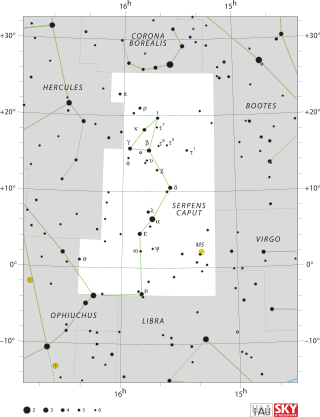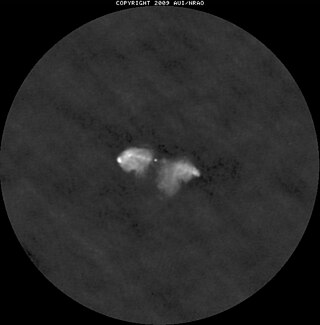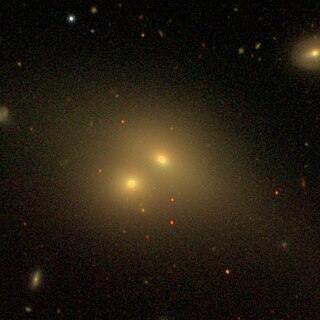
Serpens is a constellation in the northern celestial hemisphere. One of the 48 constellations listed by the 2nd-century astronomer Ptolemy, it remains one of the 88 modern constellations designated by the International Astronomical Union. It is unique among the modern constellations in being split into two non-contiguous parts, Serpens Caput to the west and Serpens Cauda to the east. Between these two halves lies the constellation of Ophiuchus, the "Serpent-Bearer". In figurative representations, the body of the serpent is represented as passing behind Ophiuchus between Mu Serpentis in Serpens Caput and Nu Serpentis in Serpens Cauda.
An active galactic nucleus (AGN) is a compact region at the center of a galaxy that emits a significant amount of energy across the electromagnetic spectrum, with characteristics indicating that the luminosity is not produced by stars. Such excess, non-stellar emissions have been observed in the radio, microwave, infrared, optical, ultra-violet, X-ray and gamma ray wavebands. A galaxy hosting an AGN is called an active galaxy. The non-stellar radiation from an AGN is theorized to result from the accretion of matter by a supermassive black hole at the center of its host galaxy.

A radio galaxy is a galaxy with giant regions of radio emission extending well beyond its visible structure. These energetic radio lobes are powered by jets from its active galactic nucleus. They have luminosities up to 1039 W at radio wavelengths between 10 MHz and 100 GHz. The radio emission is due to the synchrotron process. The observed structure in radio emission is determined by the interaction between twin jets and the external medium, modified by the effects of relativistic beaming. The host galaxies are almost exclusively large elliptical galaxies. Radio-loud active galaxies can be detected at large distances, making them valuable tools for observational cosmology. Recently, much work has been done on the effects of these objects on the intergalactic medium, particularly in galaxy groups and clusters.

Centaurus A is a galaxy in the constellation of Centaurus. It was discovered in 1826 by Scottish astronomer James Dunlop from his home in Parramatta, in New South Wales, Australia. There is considerable debate in the literature regarding the galaxy's fundamental properties such as its Hubble type and distance. NGC 5128 is one of the closest radio galaxies to Earth, so its active galactic nucleus has been extensively studied by professional astronomers. The galaxy is also the fifth-brightest in the sky, making it an ideal amateur astronomy target. It is only visible from the southern hemisphere and low northern latitudes.

3C 449 is a low-redshift Fanaroff and Riley class I radio galaxy. It is thought to contain a highly warped circumnuclear disk surrounding the central active galactic nucleus (AGN). The name signifies that it was the 449th object of the Third Cambridge Catalog of Radio Sources (3C), published in 1959.

Ursa Major B or 3C 244.1 is a radio galaxy located in the constellation Ursa Major.

3C 285 is a radio galaxy located in the constellation Canes Venatici. It is located about 1 bilion light years away. It is a Fanaroff-Riley 2 radio galaxy and is hosted in a disturbed spiral galaxy.
3C 401 is a powerful radio galaxy located in the constellation Draco. It is near the center of a rich cluster of galaxies and dominates the cluster. That is, it is the type-cD galaxy of its cluster. It has a double nucleus, indicating that it is merging with another galaxy.

3C 452 is an elliptical galaxy about 1.2 billion light years away located in the constellation Lacerta. 3C 452 is a Seyfert galaxy and a Fanaroff–Riley class 2 radio galaxy, with the radiolobes extending for about 5 arcminutes, which at the distance of 3C 452 corresponds to about 450 kiloparsecs. Fainter radio lobes extend farther away, at megaparsec scales, probably created during a former period of elevated nuclear activity. Diffuse X-ray emission has been detected in the radio lobes.

NGC 6166 is an elliptical galaxy in the Abell 2199 cluster. It lies 490 million light years away in the constellation Hercules. The primary galaxy in the cluster, it is one of the most luminous galaxies known in terms of X-ray emissions.

NGC 708 is an elliptical galaxy located 240 million light-years away in the constellation Andromeda and was discovered by astronomer William Herschel on September 21, 1786. It is classified as a cD galaxy and is the brightest member of Abell 262. NGC 708 is a weak FR I radio galaxy and is also classified as a type 2 Seyfert galaxy.

NGC 541 is a lenticular galaxy located in the constellation Cetus. It is located at a distance of circa 230 million light years from Earth, which, given its apparent dimensions, means that NGC 541 is about 130,000 light years across. It was discovered by Heinrich d'Arrest on October 30, 1864. It is a member of the Abell 194 galaxy cluster and is included in the Atlas of Peculiar Galaxies in the category galaxies with nearby fragments. NGC 541 is a radio galaxy of Fanaroff–Riley class I, also known as 3C 40A.

NGC 4636 is an elliptical galaxy located in the constellation Virgo. It is a member of the NGC 4753 Group of galaxies, which is a member of the Virgo II Groups, a series of galaxies and galaxy clusters strung out from the southern edge of the Virgo Supercluster. It is located at a distance of about 55 million light years from Earth, which, given its apparent dimensions, means that NGC 4636 is about 105,000 light years across.

NGC 545 is a lenticular galaxy located in the constellation Cetus. It is located at a distance of circa 250 million light years from Earth, which, given its apparent dimensions, means that NGC 545 is about 180,000 light years across. It was discovered by William Herschel on October 1, 1785. It is a member of the Abell 194 galaxy cluster and is included along with NGC 547 in the Atlas of Peculiar Galaxies.

NGC 547 is an elliptical galaxy and radio galaxy located in the constellation Cetus. It is located at a distance of circa 220 million light years from Earth, which, given its apparent dimensions, means that NGC 547 is about 120,000 light years across. It was discovered by William Herschel on October 1, 1785. It is a member of the Abell 194 galaxy cluster and is included along with NGC 547 in the Atlas of Peculiar Galaxies.

NGC 7720 is an elliptical galaxy located in the constellation Pegasus. It is located at a distance of about 380 million light years from Earth, which, given its apparent dimensions, means that NGC 7720 is about 180,000 light years across. NGC 7720 is the main galaxy of Abell 2634 galaxy cluster and is a radio galaxy. It was discovered by William Herschel on September 10, 1784.

NGC 5532 is an elliptical galaxy located in the constellation Boötes. It is located at a distance of about 250 million light years from Earth, which, given its apparent dimensions, means that NGC 5532 is about 110,000 light years across. It was discovered by William Herschel on March 15, 1784. It is a Fanaroff–Riley type 1 (FR1) radio galaxy.

NGC 7236 is an interacting lenticular galaxy located in the constellation Pegasus. It is located at a distance of about 300 million light years from Earth, which, given its apparent dimensions, means that NGC 7236 is about 150,000 light years across. NGC 7236 forms a pair with NGC 7237 and is a radio galaxy. It was discovered by Albert Marth on August 25, 1864.

NGC 7237 is an interacting lenticular galaxy located in the constellation Pegasus. It is located at a distance of about 350 million light years from Earth, which, given its apparent dimensions, means that NGC 7237 is about 240,000 light years across. NGC 7237 forms a pair with NGC 7236 and is a radio galaxy. It was discovered by Albert Marth on August 25, 1864.

















